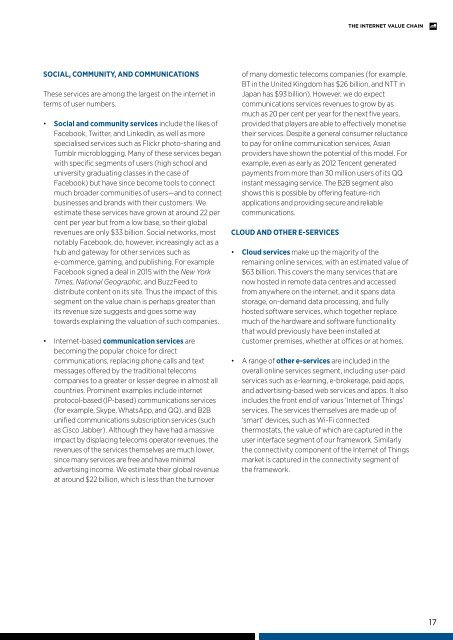The Internet Value Chain
GSMA_The-internet-Value-Chain_WEB
GSMA_The-internet-Value-Chain_WEB
You also want an ePaper? Increase the reach of your titles
YUMPU automatically turns print PDFs into web optimized ePapers that Google loves.
THE INTERNET VALUE CHAIN<br />
SOCIAL, COMMUNITY, AND COMMUNICATIONS<br />
<strong>The</strong>se services are among the largest on the internet in<br />
terms of user numbers.<br />
• Social and community services include the likes of<br />
Facebook, Twitter, and LinkedIn, as well as more<br />
specialised services such as Flickr photo-sharing and<br />
Tumblr microblogging. Many of these services began<br />
with specific segments of users (high school and<br />
university graduating classes in the case of<br />
Facebook) but have since become tools to connect<br />
much broader communities of users—and to connect<br />
businesses and brands with their customers. We<br />
estimate these services have grown at around 22 per<br />
cent per year but from a low base, so their global<br />
revenues are only $33 billion. Social networks, most<br />
notably Facebook, do, however, increasingly act as a<br />
hub and gateway for other services such as<br />
e-commerce, gaming, and publishing. For example<br />
Facebook signed a deal in 2015 with the New York<br />
Times, National Geographic, and BuzzFeed to<br />
distribute content on its site. Thus the impact of this<br />
segment on the value chain is perhaps greater than<br />
its revenue size suggests and goes some way<br />
towards explaining the valuation of such companies.<br />
• <strong>Internet</strong>-based communication services are<br />
becoming the popular choice for direct<br />
communications, replacing phone calls and text<br />
messages offered by the traditional telecoms<br />
companies to a greater or lesser degree in almost all<br />
countries. Prominent examples include internet<br />
protocol-based (IP-based) communications services<br />
(for example, Skype, WhatsApp, and QQ), and B2B<br />
unified communications subscription services (such<br />
as Cisco Jabber). Although they have had a massive<br />
impact by displacing telecoms operator revenues, the<br />
revenues of the services themselves are much lower,<br />
since many services are free and have minimal<br />
advertising income. We estimate their global revenue<br />
at around $22 billion, which is less than the turnover<br />
of many domestic telecoms companies (for example,<br />
BT in the United Kingdom has $26 billion, and NTT in<br />
Japan has $93 billion). However, we do expect<br />
communications services revenues to grow by as<br />
much as 20 per cent per year for the next five years,<br />
provided that players are able to effectively monetise<br />
their services. Despite a general consumer reluctance<br />
to pay for online communication services, Asian<br />
providers have shown the potential of this model. For<br />
example, even as early as 2012 Tencent generated<br />
payments from more than 30 million users of its QQ<br />
instant messaging service. <strong>The</strong> B2B segment also<br />
shows this is possible by offering feature-rich<br />
applications and providing secure and reliable<br />
communications.<br />
CLOUD AND OTHER E-SERVICES<br />
• Cloud services make up the majority of the<br />
remaining online services, with an estimated value of<br />
$63 billion. This covers the many services that are<br />
now hosted in remote data centres and accessed<br />
from anywhere on the internet, and it spans data<br />
storage, on-demand data processing, and fully<br />
hosted software services, which together replace<br />
much of the hardware and software functionality<br />
that would previously have been installed at<br />
customer premises, whether at offices or at homes.<br />
• A range of other e-services are included in the<br />
overall online services segment, including user-paid<br />
services such as e-learning, e-brokerage, paid apps,<br />
and advertising-based web services and apps. It also<br />
includes the front end of various ‘<strong>Internet</strong> of Things’<br />
services. <strong>The</strong> services themselves are made up of<br />
‘smart’ devices, such as Wi-Fi connected<br />
thermostats, the value of which are captured in the<br />
user interface segment of our framework. Similarly<br />
the connectivity component of the <strong>Internet</strong> of Things<br />
market is captured in the connectivity segment of<br />
the framework.<br />
17


